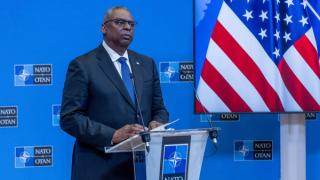The participation of the ‘Asia Pacific 4’ — Australia, Japan, New Zealand, and South Korea — in the NATO Summit in Madrid last month has generated considerable debate about the benefits and shortcomings of strengthening links between America’s Asian and European allies. What received less attention, however, was the elevation of military deterrence in the Biden administration’s strategy for managing the Ukraine conflict. While not immediately obvious, this turn of events could have material consequences for Washington’s Asia strategy.
Indeed, US President Joe Biden used the occasion to announce a range of “additional actions to strengthen NATO’s deterrence and defence”. Most of these new commitments centred around ground forces, including additional force rotations through the Baltics and deploying more air defence to Germany and Italy. However, they also included significant air force and naval components. Two additional Arleigh Burke-class destroyers will be deployed to Rota Naval Base in Spain by 2024, bringing the total number there to six. Biden also announced the deployment of two squadrons of F-35A Joint Strike Fighters to Lakenheath Air Base in the United Kingdom — though it is not entirely clear whether these are permanent or rotational deployments, or a repackaging of long-planned deployments already in motion.
What will frustrate many in Asia is that the urgency evident in these new US commitments to collective defence in Europe is yet to be mirrored in parallel efforts in the Indo-Pacific.
These announcements follow on the heels of other new or extended air and naval deployments in recent months, and surging security assistance to allies and partners on the frontlines of Russian aggression. Indeed, the total value of US military assistance delivered to Ukraine since the Biden administration took office has now exceeded USD 8 billion, including thousands of anti-aircraft and anti-armour munitions, nearly 130 field artillery pieces, and, most recently, advanced air defence and precision strike systems. In short, all of the above highlight the growing number of sophisticated US military systems being forward-deployed across Europe, whether American-operated or otherwise. Regardless of whether America’s Indo-Pacific allies and partners believe these decisions to be strategically sound, the reality is that new or expanded hard power commitments to Europe will have real material consequences for US force posture and security assistance programmes in Asia.
Prioritisation in context
The administration’s initial approach to the crisis in Ukraine, pivoting on “economic punishment, allied burden-sharing, and [supporting] resistance by local forces”, was commended for its restraint. But as my colleague and I cautioned earlier this year, there were always risks that the scale of America’s military support for Ukraine could “slip beyond Biden’s original articulation of limited [US] interests”, with consequences for resourcing Washington’s Indo-Pacific Strategy. In that sense, new US force posture commitments and the expanding scope of its security assistance across Europe clearly demonstrate that the administration’s approach to the crisis is leaning increasingly heavily on military deterrence.
Allies and partners in the Indo-Pacific will view this trend with mixed feelings. On the positive side, Washington’s response to the war in Ukraine to date has shown that, when roused, it can still mobilise unmatched military resources and political support against shared threats. In the context of America’s struggles to right-size its military footprint in the Middle East (quantitatively and qualitatively), the administration’s approach represents a far more prudent use of military resources: deploying F-35s and destroyers to deter a technologically advanced adversary in Europe is a much wiser use of top-shelf military hardware than, say, fighting insurgents in the Middle East. Equally important, it has shown that the Biden administration’s consistent rhetoric regarding the value it places on its traditional alliances is genuine, that it can no longer ‘do’ deterrence alone, and that collective efforts are required.
Besides, the basic idea that these latest commitments to Europe should have been straight-swapped to Asia instead mischaracterises the bigger strategic picture that the United States must deal with. Some see Ukraine as a distraction from resourcing more pressing deterrence challenges in Asia, and there is certainly an element of truth to this. But for better or worse, the depth of US ties and commitments to Europe make such a snap-shift in focus away from the continent highly unlikely. Furthermore, beyond the moral and normative justifications for supporting Ukraine, America’s ability to stay focused on Asia depends in large part on keeping events on the European continent in hand. In fact, one could argue that exhausting Russian military power by proxy is sensible opportunism, given that US strategy in recent years has sought to pivot away from the ‘two-front’ war problem — that is, the chance that America may have to defend against Chinese and Russian aggression in Asia and Europe at the same time — that has long animated America’s military planners.
When one looks at the distribution of US force posture and security assistance between global theatres over the last two decades, it is quite clear that Asia has repeatedly lost out to Europe and the Middle East — even as the balance of power in Asia has tilted rapidly in China’s favour.
What will frustrate many in Asia, however, is that the urgency evident in these new commitments to collective defence in Europe is yet to be mirrored in parallel efforts in the Indo-Pacific. This is not a new phenomenon: when one looks at the distribution of US force posture and security assistance between global theatres over the last two decades, it is quite clear that Asia has repeatedly lost out to Europe and the Middle East — even as the balance of power in Asia has tilted rapidly in China’s favour. Granted, the Biden administration has said all the right things about the Indo-Pacific being its “priority theatre” and has proposed, or persisted with, a range of initiatives designed to get after different aspects of strategic competition in the region.
But slow progress on implementing these lines of effort — whether right-sizing the Pentagon’s flagship Pacific Deterrence Initiative or empowering regional allies to better manage their own affairs — predated the conflict in Ukraine, leaving many question marks hanging over America’s ability to truly prioritise Asia in a worsening global security environment. In that respect, Indo-Pacific allies and partners will also be wary of the material pressures — on both America and themselves — that could well result from redoubled US commitments to European deterrence. Indeed, the administration’s decision to shift the goalposts for success vis-à-vis Ukraine (from initially repelling Russia’s invasion to weakening its long-term national power via proxy) carries with it risks for what many see as an already under-resourced Asia strategy. In short, increasing demand for a stronger US military presence and for greater numbers of advanced capabilities in Europe are, in one way or another, directly in competition with demand signals coming from the Indo-Pacific.
Growing competition for limited resources
Washington is by no means deaf to the wants of its regional allies for more high-end deterrence capabilities. US Indo-Pacific Commander Admiral John Aquilino recently flagged the possibility of more F-22 and F-35 forward deployments to key operating locations in Asia, while “dynamic force deployments” of fifth-generation aircraft to the region for joint exercises with frontline allies operating similar platforms are growing in frequency. Rather, longer deployments and higher operational tempos of top-shelf assets in both Europe and Asia will create additional operation and maintenance costs — the sort which the Department of Defence has already struggled to keep on top of. Furthermore, Congressional lawmakers will reportedly seek a further expansion of the European Deterrence Initiative, which has attracted over USD 30 billion in dedicated funding since 2015, a move which could yet see the number and sophistication of advanced capabilities deployed to the region increase.
The ‘success’ of deterrence is notoriously difficult to measure; less so are the quantities of advanced US capabilities being sought by frontline allies and partners in Europe. Whether by drawdowns from Pentagon stockpiles or through expanded foreign military sales, Washington’s evident willingness to meet these demands could see Indo-Pacific countries face heightened competition for access to advanced weaponry. Evidence suggests this is already happening. Taiwanese officials say they expect delays to deliveries of surface-to-air missiles and self-propelled howitzers due to "tight" production constraints in the US and “changes in the international situation” (read: demand from Ukraine).
Competition does not come from Kyiv alone, either. Australia’s recent request for 20 High Mobility Artillery Rocket System (HIMARS) launchers is dwarfed by Poland’s request for a whopping 500 such systems, while Ukraine has received twelve configured HIMARS batteries and hundreds of rounds of ammunition since June. Couple these and other demands for advanced weaponry with the well-known capacity challenges afflicting the US defence industrial base — and the absence of a cohesive strategy to address those problems — it is clear that customers of US military sales in Asia will face stiffer competition for a place at the head of the queue in the years ahead.
None of the above is to detract from the merit or necessity of shoring-up US posture in Europe and empowering frontlines allies and partners there to defend themselves, nor take away from the potential long-term strategic pay-offs of sapping Russian power. Many of America’s Indo-Pacific allies and partners appreciate these points. But they are also tired of waiting for the United States to show the urgency it has shown in Europe — historically and contemporaneously — in their own region. It is this sort of mindset, as much as the allocation of new military resources themselves, that America’s allies and partners in Asia would like to see in deed, not just in word.






